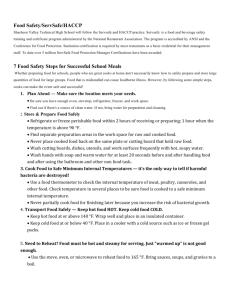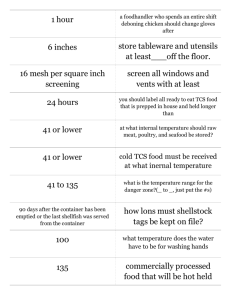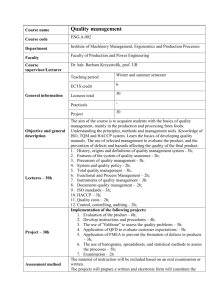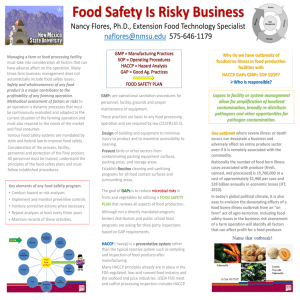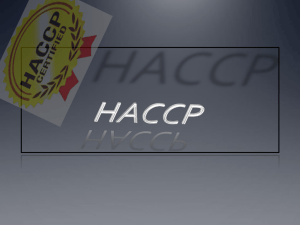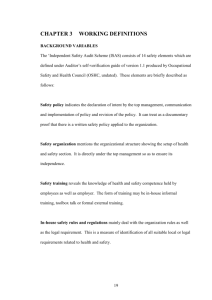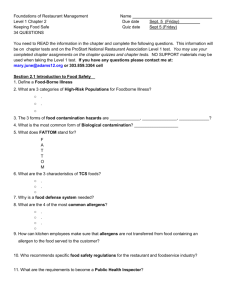ServSafe Chapters 6-8
advertisement
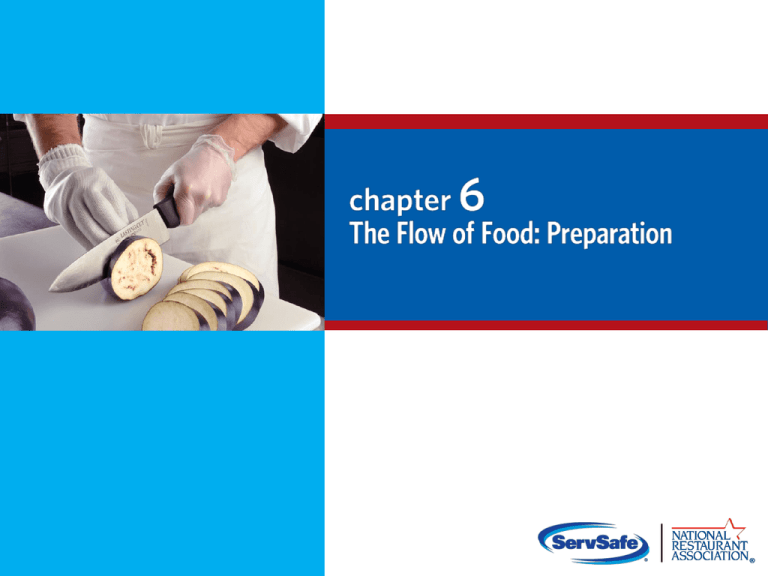
General Preparation Practices Objectives: 6-2 Prevent cross-contamination and time-temperature abuse Thaw food correctly Cook food to a minimum internal temperature Cool and reheat food to the correct temperature in the correct amount of time General Preparation Practices When prepping food: Only remove as much food from the cooler as you can prep in a short period of time o 6-3 This limits time-temperature abuse Return prepped food to the cooler or cook it as quickly as possible Make sure workstations, cutting boards, and utensils are clean and sanitized General Preparation Practices Food and color additives: 6-4 Only use additives approved by your local regulatory authority NEVER use more additives than are allowed by law NEVER use additives to alter the appearance of food Do NOT sell produce treated with sulfites before it was received in the operation NEVER add sulfites to produce that will be eaten raw General Preparation Practices Present food honestly: 6-5 Do NOT use the following to misrepresent the appearance of food o Food additives or color additive o Colored overwraps o Lights Food not presented honestly must be thrown out General Preparation Practices Corrective actions: 6-6 Food must be thrown out in the following situations o When it is handled by staff who have been restricted or excluded from the operation due to illness o When it is contaminated by hands or bodily fluids from the nose or mouth o When it has exceeded the time and temperature requirements designed to keep food safe Thawing Four methods for thawing food: 1. Thaw food in a cooler, keeping its temperature at 41°F (5°C) or lower 2. Submerge food under running water at 70°F (21°C) or lower o Never let the temperature of the food go above 41°F (5°C) or lower for longer than four hours 3. Thaw food in a microwave, only if cooked immediately after thawing 4. Thaw as part of the cooking process 6-7 Prepping Specific Food Produce: 6-8 Make sure produce does not touch surfaces exposed to raw meat, seafood, or poultry Wash it thoroughly under running water before o Cutting o Cooking o Combining with other ingredients Prepping Specific Food Produce: Produce can be washed in water containing ozone to sanitize it o 6-9 Check with your local regulatory authority When soaking or storing produce in standing water or an ice-water slurry, do NOT mix o Different items o Multiple batches of the same item Prepping Specific Food Produce: 6-10 Refrigerate and hold sliced melons, cut tomatoes, and cut leafy greens at 41°F (5°C) or lower Do NOT serve raw seed sprouts if primarily serving a high-risk population Prepping Specific Food Eggs and egg mixtures: 6-11 Handle pooled eggs (if allowed) with care o Cook promptly after mixing or store at 41°F (5°C) or lower o Clean and sanitize containers between batches Consider using pasteurized shell eggs or egg products when prepping dishes that need little or no cooking Prepping Specific Food Eggs for high-risk populations: Use pasteurized shell eggs if eggs will be pooled Use pasteurized eggs or egg products when serving raw or undercooked dishes o 6-12 Unpasteurized shell eggs can be used if the dish will be cooked all the way through (i.e. omelets, cakes) Prepping Specific Food Salads containing TCS food: 6-13 Make sure leftover TCS ingredients (i.e. pasta, chicken, potatoes) have been handled safely by ensuring that they were o Cooked, held, and cooled correctly o Stored for less than seven days at 41°F (5°C) or lower Prepping Specific Food Ice: 6-14 NEVER use ice as an ingredient if it was used to keep food cold Transfer ice using clean and sanitized containers and scoops NEVER hold ice in containers that held chemicals or raw meat, seafood, or poultry Prepping Specific Food Ice: 6-15 Store ice scoops outside ice machines in a clean, protected location NEVER use a glass to scoop ice or touch ice with hands Preparation Practices That Have Special Requirements You need a variance if prepping food in these ways: 6-16 Packaging fresh juice on-site for sale at a later time, unless the juice has a warning label Smoking food to preserve it but not to enhance flavor Using food additives or components to preserve or alter food so it no longer needs time and temperature control for safety Curing food Preparation Practices You need a variance if prepping food in these ways: 6-17 Packaging food using a reduced-oxygen packaging (ROP) method Sprouting seeds or beans Offering live shellfish from a display tank Custom-processing animals for personal use (i.e. dressing a deer) Review 6-12 Review What’s wrong with this picture? 6-13 Review What’s wrong with this picture? 6-14 Review What’s wrong with this picture? 6-15 Review What’s wrong with this picture? 6-16 Review What’s wrong with this picture? 6-17 Cooking Food When cooking TCS food, the internal portion must: 6-18 Reach the required minimum internal temperature Hold that temperature for a specific amount of time Cooking Food When checking temperatures: Pick a thermometer with a probe that is the correct size for the food Check the temperature in the thickest part of the food o 6-19 Take at least two readings in different locations Cooking Requirements for Specific Food Minimum internal cooking temperature: 165°F (74°C) for 15 seconds 6-20 Poultry—whole or ground chicken, turkey, or duck Stuffing made with fish, meat, or poultry Stuffed meat, seafood, poultry, or pasta Dishes that include previously cooked, TCS ingredients Cooking Requirements for Specific Food Minimum internal cooking temperature: 155°F (68°C) for 15 seconds 6-21 Ground meat—beef, pork, and other meat Injected meat—including brined ham and flavor-injected roasts Mechanically tenderized meat Ratites including ostrich and emu Ground seafood—including chopped or minced seafood Shell eggs that will be hot-held for service Cooking Requirements for Specific Food Minimum internal cooking temperature: 145°F (63°C) for 15 seconds 6-22 Seafood—including fish, shellfish, and crustaceans Steaks/chops of pork, beef, veal, and lamb Commercially raised game Shell eggs that will be served immediately Cooking Requirements for Specific Food Minimum internal cooking temperature: 145°F (63°C) for four minutes Roasts of pork, beef, veal, and lamb Alternate cooking times/temperatures o o o o o o o o o 6-23 130°F (54°C) 131°F (55°C) 133°F (56°C) 135°F (57°C) 136°F (58°C) 138°F (59°C) 140°F (60°C) 142°F (61°C) 144°F (62°C) 112 minutes 89 minutes 56 minutes 36 minutes 28 minutes 18 minutes 12 minutes 8 minutes 5 minutes Cooking Requirements for Specific Food Minimum internal cooking temperature: 135°F (57°C) 6-24 Fruit, vegetables, grains (rice, pasta), and legumes (beans, refried beans) that will be hot-held for service Cooking TCS Food in a Microwave Minimum internal cooking temperature: 165°F (74°C) 6-25 Meat Seafood Poultry Eggs Cooking TCS Food in a Microwave Guidelines for microwave cooking: 6-26 Cover food to prevent the surface from drying out Rotate or stir it halfway through cooking so heat reaches the food more evenly Let it stand for at least two minutes after cooking to let the food temperature even out Check the temperature in at least two places to make sure the food is cooked through Partial Cooking During Preparation If partially cooking meat, seafood, poultry, or eggs or dishes containing these items: 6-27 NEVER cook the food longer than 60 minutes during initial cooking Cool the food immediately after initial cooking Freeze or refrigerate the food after cooling it Heat the food to at least 165˚F (74˚C) for 15 seconds before selling or serving it Cool the food if it will not be served immediately or held for service Consumer Advisories If your menu includes raw or undercooked TCS items, you must: 6-28 Note it on the menu next to the items o Asterisk the item o Place a footnote at the menu bottom indicating the item is raw, undercooked, or contains raw or undercooked ingredients Advise customers who order this food of the increased risk of foodborne illness o Post a notice in the menu o Provide this information using brochures, table tents, or signs Consumer Advisories The FDA advises against offering these items on a children’s menu if they are raw or undercooked: 6-29 Meat Poultry Seafood Eggs Operations That Mainly Serve High-Risk Populations NEVER serve: 6-30 Raw seed sprouts Raw or undercooked eggs, meat, or seafood o Over-easy eggs o Raw oysters on the half shell o Rare hamburgers Review 6-31 Review What is the minimum internal cooking temperature? A. 165ºF (74ºC) for 15 seconds B. 155ºF (68ºC) for 15 seconds C. 145ºF (63ºC) for 15 seconds D. 135ºF (57ºC) for 15 seconds Ground meat 6-32 Review What is the minimum internal cooking temperature? A. 165ºF (74ºC) for 15 seconds B. 155ºF (68ºC) for 15 seconds C. 145ºF (63ºC) for 15 seconds D. 135ºF (57ºC) for 15 seconds Beef steak 6-33 Review What is the minimum internal cooking temperature? A. 165ºF (74ºC) for 15 seconds B. 155ºF (68ºC) for 15 seconds C. 145ºF (63ºC) for 15 seconds D. 135ºF (57ºC) for 15 seconds Poultry 6-34 Review What is the minimum internal cooking temperature? A. 165ºF (74ºC) for 15 seconds B. 155ºF (68ºC) for 15 seconds C. 145ºF (63ºC) for 15 seconds D. 135ºF (57ºC) for 15 seconds Shell eggs for hot-holding 6-35 Review What is the minimum internal cooking temperature? A. 165ºF (74ºC) for 15 seconds B. 155ºF (68ºC) for 15 seconds C. 145ºF (63ºC) for 15 seconds D. 135ºF (57ºC) for 15 seconds Swordfish 6-36 Review What is the minimum internal cooking temperature? A. 165ºF (74ºC) B. 155ºF (68ºC) C. 145ºF (63ºC) D. 135ºF (57ºC) Cooked rice 6-37 Cooling Food Cooling requirements: 6-31 Cooling Food If you cool food from 135˚F to 70˚F (57˚C to 21˚C) in less than two hours: Use the remaining time to cool it to 41˚F (5˚C) or lower The total cooling time cannot be longer than six hours Example: 6-32 If you cool food from 135˚F to 70˚F (57˚C to 21˚C) in one hour Then you have five hours to get the food to 41˚F (5˚C) or lower Methods for Cooling Food Before cooling food, start by reducing its size: 6-33 Cut larger items into smaller pieces Divide large containers of food into smaller containers or shallow pans Methods for Cooling Food Methods for cooling food safely and quickly: 6-34 Place food in an ice-water bath Stir it with an ice paddle Place it in a blast chiller Storing Food for Further Cooling When storing food for further cooling: Loosely cover food containers before storing them Food can be left uncovered if protected from contamination o 6-35 Storing uncovered containers above other food, especially raw seafood, meat, and poultry, will help prevent cross-contamination Reheating Food Food reheated for immediate service: Can be reheated to any temperature if it was cooked and cooled correctly Food reheated for hot-holding: 6-36 Must be reheated to an internal temperature of 165°F (74°C) for 15 seconds within two hours Reheat commercially processed and packaged ready-to-eat food to an internal temperature of at least 135°F (57°C) Review Meat sauce was cooled from 135ºF to 70ºF (57ºC to 21ºC) in 1 hour and then from 70ºF to 41ºF (21ºC to 5ºC) in 4 hours. Was it cooled correctly? A. Yes B. No 6-38 Review Chili was cooled from 135ºF to 70ºF (57ºC to 21ºC) in 2 hours and then from 70ºF to 41ºF (21ºC TO 5ºC) in 4 hours. Was it cooled correctly? A. Yes B. No 6-39 Review Soup was reheated to 165ºF (74ºC) for 15 seconds within 4 hours. Was it reheated correctly? A. Yes B. No 6-40 Service Objectives: ● Holding hot food ● Holding cold food ● Using time as a method of control for food ● Preventing contamination in self-service areas and when serving food to customers 7-2 Guidelines for Holding Food Food covers and sneeze guards: Cover food and install sneeze guards to protect food from contaminants o 7-3 Covers protect food from contamination and help maintain food temperatures Guidelines for Holding Food Temperature: 7-4 Hold TCS food at the correct temperature o Hot food: 135°F(57°C) or higher o Cold food: 41°F(5°C) or lower Check temperatures at least every four hours o Throw out food not at 41°F (5°C) or lower o Check temperatures every two hours to leave time for corrective action Guidelines for Holding Food Temperature: NEVER use hot-holding equipment to reheat food unless it’s designed for it o 7-5 Reheat food correctly, and then move it into a holding unit Holding Food Without Temperature Control Cold food can be held without temperature control for up to six hours if: It was held at 41°F (5°C) or lower before removing it from refrigeration It does not exceed 70°F (21°C) during service o It has a label specifying o o 7-6 Throw out food that exceeds this temperature Time it was removed from refrigeration Time it must be thrown out It is sold, served, or thrown out within six hours Holding Food Without Temperature Control Hot food can be held without temperature control for up to four hours if: 7-7 It was held at 135°F (57°C) or higher before removing it from temperature control It has a label specifying when the item must be thrown out It is sold, served, or thrown out within four hours Kitchen Staff Guidelines Prevent contamination when serving food: Wear single-use gloves whenever handling ready-to-eat food o 7-8 As an alternative use spatulas, tongs, deli sheets, or other utensils Use clean and sanitized utensils for serving o Use separate utensils for each food o Clean and sanitize utensils after each task o At minimum, clean and sanitize them at least once every four hours Kitchen Staff Guidelines for Serving Food Prevent contamination when serving food: 7-9 Store serving utensils correctly between uses o On a clean and sanitized food-contact surface o In the food with the handle extended above the container rim Service Staff Guidelines for Serving Food Handling dishes and glassware: Correct Incorrect 7-10 Preset Tableware If you preset tableware: Prevent it from being contaminated o Wrap or cover the items Table settings do not need to be wrapped or covered if extra settings: 7-11 Are removed when guests are seated Are cleaned and sanitized after guests have left Re-serving Food NEVER re-serve: Food returned by one customer to another customer Uncovered condiments Uneaten bread Plate garnishes Generally, only unopened, prepackaged food in good condition can be re-served: 7-12 Condiment packets Wrapped crackers or breadsticks Self-Service Areas Prevent time-temperature abuse and contamination: 7-13 Use sneeze guards o Must be located 14" (36cm) above the counter o Must extend 7" (18cm) beyond the food Identify all food items o Label food o Place salad dressing names on ladle handles Self-Service Areas Prevent time-temperature abuse and contamination: 7-14 Keep hot food at 135°F (57°C) or higher Keep cold food at 41°F (5°C) or lower Keep raw meat, fish, and poultry separate from ready-to-eat food Do NOT let customers refill dirty plates or use dirty utensils at self-service areas Self-Service Areas Prevent time-temperature abuse and contamination: 7-15 Stock food displays with the correct utensils for dispensing food Do NOT use ice as an ingredient if it was used to keep food or beverages cold Labeling Bulk Food in Self-Service Areas When labeling bulk food in self-service areas: Make sure the label is in plain view of the customer Include the manufacturer or processor label provided with the food o 7-16 As an alternative, provide the information using a card, sign, or other labeling method Labeling Bulk Food in Self-Service Areas A label is not needed for bulk unpackaged food, such as bakery products, if: 7-17 The product makes no claim regarding health or nutrient content No laws requiring labeling exist The food is manufactured or prepared on the premises The food is manufactured or prepared at another regulated food operation or processing plant owned by the same person Off-Site Service When delivering food off-site: 7-18 Use insulated, food-grade containers designed to stop food from mixing, leaking, or spilling Clean the inside of delivery vehicles regularly Check internal food temperatures Label food with a use-by date and time, and reheating and service instructions Off-Site Service When delivering food off-site: 7-19 Make sure the service site has the correct utilities o Safe water for cooking, dishwashing, and handwashing o Garbage containers stored away from food-prep, storage, and serving areas Store raw meat, poultry, and seafood, and ready-to-eat items separately Vending Machines To keep vended food safe: Check product shelf life daily o 7-20 Refrigerated food prepped on-site and not sold in seven days must be thrown out Keep TCS food at the correct temperature Dispense TCS food in its original container Wash and wrap fresh fruit with edible peels before putting it in the machine Review 7-13 Activity Is this food being held safely? A. Yes B. No Green bean casserole hot-held at 120ºF (49ºC) 7-14 Activity Is this food being held safely? A. Yes B. No Potato salad held in cold-holding at 41ºF (5ºC) 7-15 Activity Is this food being held safely? A. Yes B. No Soup is placed in a hot-holding unit at 40ºF (4ºC) 7-16 Activity Is this food being held safely? A. Yes B. No Pasta salad held without temperature control at 75ºF (24ºC) 7-17 Service Objectives: 8-2 Food safety management systems Active managerial control Hazard Analysis Critical Control point (HACCP) Food Safety Management Systems Food safety management system: 8-3 Group of practices and procedures intended to prevent foodborne illness Actively controls risks and hazards throughout the flow of food Food Safety Programs These are the foundation of a food safety management system: 8-4 Personal hygiene program Food safety training program Supplier selection and specification program Quality control and assurance program Food Safety Programs These are the foundation of a food safety management system: 8-5 Cleaning and sanitation program Standard operating procedures (SOPs) Facility design and equipment maintenance program Pest control program Active Managerial Control Focuses on controlling the five most common risk factors for foodborne illness: 1. Purchasing food from unsafe sources 2. Failing to cook food adequately 3. Holding food at incorrect temperatures 4. Using contaminated equipment 5. Practicing poor personal hygiene 8-6 Active Managerial Control There are many ways to achieve active managerial control in the operation: Training programs Manager supervision Incorporation of standard operating procedures (SOPs) HACCP These are critical to the success of active managerial control: 8-7 Monitoring critical activities in the operation Taking the necessary corrective action when required Verifying that the actions taken control the risks factors Active Managerial Control The FDA provides recommendations for controlling the common risk factors for foodborne illness: 8-8 Demonstration of knowledge Staff health controls Controlling hands as a vehicle of contamination Time and temperature parameters for controlling pathogens Consumer advisories HACCP The HACCP approach: 8-9 HACCP is based on identifying significant biological, chemical, or physical hazards at specific points within a product’s flow through an operation Once identified, hazards can be prevented, eliminated, or reduced to safe levels HACCP To be effective, a HACCP system must be based on a written plan: 8-10 It must be specific to each facility’s menu, customers, equipment, processes, and operations A plan that works for one operation may not work for another The 7 HACCP Principles The seven HACCP principles: 1. Conduct a hazard analysis 2. Determine critical control points (CCPs) 3. Establish critical limits 4. Establish monitoring procedures 5. Identify corrective actions 6. Verify that the system works 7. Establish procedures for record keeping and documentation 8-11 The 7 HACCP Principles Principle 1: Conduct a hazard analysis 8-12 Identify potential hazards in the food served by looking at how it is processed Identify TCS food items and determine where hazards are likely to occur for each one; look for biological, chemical, and physical contaminants The 7 HACCP Principles Principle 2: Determine critical control points (CCPs) 8-13 Find points in the process where identified hazards can be prevented, eliminated, or reduced to safe levels—these are the CCPs Depending on the process, there may be more than one CCP The 7 HACCP Principles Principle 3: Establish critical limits 8-14 For each CCP, establish minimum or maximum limits These limits must be met to o Prevent or eliminate the hazard o Reduce it to a safe level Critical Limit The 7 HACCP Principles Principle 4: Establish monitoring procedures Determine the best way to check critical limits o 8-15 Make sure they are consistently met Identify who will monitor them and how often The 7 HACCP Principles Principle 5: Identify corrective actions 8-16 Identify steps that must be taken when a critical limit is not met Determine these steps in advance The 7 HACCP Principles Principle 6: Verify that the system works Determine if the plan is working as intended Evaluate the plan on a regular basis using 8-17 o Monitoring charts o Records o Hazard analysis Determine if your plan prevents, reduces, or eliminates identified hazards The 7 HACCP Principles Principle 7: Establish procedures for record keeping and documentation Keep records for these actions: 8-18 Monitoring activities Corrective actions Validating equipment (checking for good working condition) Working with suppliers (invoices, specifications, etc.) HACCP These specialized processing methods require a variance and may require a HACCP plan: 8-19 Smoking food as a method to preserve it (but not to enhance flavor) Using food additives or components such as vinegar to preserve or alter food so it no longer requires time and temperature control for safety Curing food Custom-processing animals HACCP These specialized processing methods require a variance and may require a HACCP plan: 8-20 Packaging food using ROP methods including o MAP o Vacuum-packed o Sous vide Treating (e.g. pasteurizing) juice on-site and packaging it for later sale Sprouting seeds or beans Activity 8-11 HACCP Principles Analogy The Situation 8-12 HACCP Principles Analogy 1. Conduct a hazard analysis 8-13 HACCP Principles Analogy 2. Determine critical control points 8-14 HACCP Principles Analogy 3. Establish critical limits 8-15 HACCP Principles Analogy 4. Establish monitoring procedures 8-16 HACCP Principles Analogy 5. Identify corrective actions 8-17 HACCP Principles Analogy 6. Verify the system works 8-18 HACCP Principles Analogy 7. Establish record keeping and documentation procedures 8-19 Review 8-30 Review Checking to see if critical limits are met A. Hazard analysis B. Critical control points C. Critical limits D. Monitoring E. Corrective action F. Verification G. Record keeping and documentation 8-31 Review Keeping HACCP plan documents A. Hazard analysis B. Critical control points C. Critical limits D. Monitoring E. Corrective action F. Verification G. Record keeping and documentation 8-32 Review Assessing risks within the flow of food A. Hazard analysis B. Critical control points C. Critical limits D. Monitoring E. Corrective action F. Verification G. Record keeping and documentation 8-33 Review Specific places within the flow of food where hazards can be prevented, eliminated, or reduced to a safe level A. Hazard analysis B. Critical control points C. Critical limits D. Monitoring E. Corrective action F. Verification G. Record keeping and documentation 8-34 Review Predetermined step taken when a critical limit is not met A. Hazard analysis B. Critical control points C. Critical limits D. Monitoring E. Corrective action F. Verification G. Record keeping and documentation 8-35 Review Minimum or maximum boundaries that must be met to prevent a hazard A. Hazard analysis B. Critical control points C. Critical limits D. Monitoring E. Corrective action F. Verification G. Record keeping and documentation 8-36 Review Determining if the HACCP plan is working as intended A. Hazard analysis B. Critical control points C. Critical limits D. Monitoring E. Corrective action F. Verification G. Record keeping and documentation 8-37
